 |
Of all the aspersions hurled against classical music, the one that makes the least sense is that it all sounds the same. Of course, that's just ignorance – the same could (and often is) said about Bach, the blues or any other style one knows nothing about. As with any worthy pursuit, familiarity breeds a fascination with subtlety and detail completely lost on causal observers. the one that makes the least sense is that it all sounds the same. Of course, that's just ignorance – the same could (and often is) said about Bach, the blues or any other style one knows nothing about. As with any worthy pursuit, familiarity breeds a fascination with subtlety and detail completely lost on causal observers.
Yet, with Antonio Vivaldi, there's at least a grain of truth in this disparaging barb. Although he wrote 39 operas, 73 sonatas and loads of religious music, Vivaldi is best known for his concertos.  And there lies the problem. While Beethoven wrote seven concertos, Brahms four and Bach, Haydn, Handel and Mozart at most a few dozen, Vivaldi wrote over 500 (and more are being uncovered each year)! When you're that prolific, some recycling and lapsing into formula is inevitable. And there lies the problem. While Beethoven wrote seven concertos, Brahms four and Bach, Haydn, Handel and Mozart at most a few dozen, Vivaldi wrote over 500 (and more are being uncovered each year)! When you're that prolific, some recycling and lapsing into formula is inevitable.
The details of Vivaldi's life are surprisingly sketchy. Even extensive modern scholarship leaves many wide gaps in his whereabouts and activities. Biographies typically devote at most a few dozen pages to his career and the rest to his works. Indeed, only in 1962 was his birthdate determined from baptismal records to have been 1678; prior writers had placed it as early as 1669.
Vivaldi learned the violin from his father, a Venetian barber who played in the orchestra of San Marco cathedral. 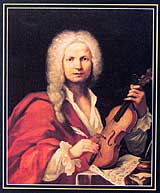 He was ordained in 1703 and, thanks to his flaming hair (blanched in his only color portrait, perhaps due to a powdered wig), became known as the Red Priest, but his ecclesiastical functions were forestalled by bronchial asthma, which denied him the stamina to say a complete mass. The next year he became a violin teacher at the Ospedale della Pietŕ, an orphanage for a thousand girls, of whom a few dozen received intensive musical training. In 1716, he became the music director. He was ordained in 1703 and, thanks to his flaming hair (blanched in his only color portrait, perhaps due to a powdered wig), became known as the Red Priest, but his ecclesiastical functions were forestalled by bronchial asthma, which denied him the stamina to say a complete mass. The next year he became a violin teacher at the Ospedale della Pietŕ, an orphanage for a thousand girls, of whom a few dozen received intensive musical training. In 1716, he became the music director.
Among his duties was to provide two concertos per month (even while he was away) for concerts given each Sunday by the school orchestra (in which, to the amazement of visitors, the students played all the instruments, rather than just the ones deemed suitable for ladies, and whose sensual attraction undoubtedly contributed to their widespread fame among gentlemen patrons). Despite a bumpy relationship with the school administrators, Vivaldi enjoyed considerable freedom, not only to fill his compositions with whimsy and technical hurdles to challenge his students and display their artistry, but to travel extensively to fulfill commissions and to stage his operas. Although Vivaldi negotiated sizable fees for his work, he spent prolifically and died in poverty during a 1741 trip to Vienna, where he was given a pauper's funeral.
For nearly 200 years, Vivaldi was a historical footnote, although a somewhat influential one – the twelve concerti comprising his first publication (L'estro armonico, 1711) were widely imitated. Yet, as Groves' Dictionary aptly observes, the current repertory system lay well in the future; instead there was a constant need for new output. 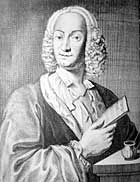 Thus, soon after his death his few publications were forgotten and the rest of his output remained unknown. His only lasting recognition came from the fervent admiration of Bach, who modeled his own concerto style after Vivaldi's and adapted for keyboard nine Vivaldi violin concerti (even though Bach devotees tended to disparage the source). Thus, soon after his death his few publications were forgotten and the rest of his output remained unknown. His only lasting recognition came from the fervent admiration of Bach, who modeled his own concerto style after Vivaldi's and adapted for keyboard nine Vivaldi violin concerti (even though Bach devotees tended to disparage the source).
That suddenly changed in 1926 when a monastery presented a massive cache of old scores to Turin University for appraisal prior to sale to fund repairs. The collection was traced back to a Count Durazzo, who had purchased the lot from the Ospedale, donated half to the monastery and passed the remainder to his heirs. Lawsuits overrode the Count's will, which forbade publication, and private donations kept the scores intact and off the antiques market. Among them were a huge number of Vivaldi's handwritten originals, including over 300 previously unknown works. Scholars delved through the treasure and were astounded by the unsuspected diversity and range. Since World War II, a burgeoning of biographies, catalogs, analyses, performances and recordings have led to a thorough reevaluation of Vivaldi's significance and a new understanding and appreciation of the scope of his art.
As his first biographer Marc Pincerle noted, Vivaldi's concerti fall into a general three-part pattern in which a majestic, vital opening and a rapid, playful finale are separated by a slow, lyrical movement of unprecedented depth, thus greatly extending the convention of the time of providing a brief, calming, functional interlude between the excitement of the outer movements. Michael Talbot found his style distinctive, featuring melodies of wide intervals based on the tonic triad chord and broken into small repeated phrases, forceful and syncopated rhythms based on folk material, and irregular, abrupt harmonic changes. 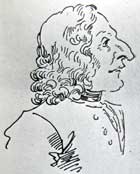 While Pincherle sees Vivaldi as poised between the old polyphonic and new accompanied treble melody styles, H. C. Robbins Landon views him as a formalist, adhering to simple key progressions (often I-V-VI-I) and relying heavily upon the ritornello format, in which repetitions of a fundamental theme frame inventive solo flights of decorative sequenced passagework (a precursor to the popular rondo style of nearly all classical and romantic concerto finales). Pincherle suggests that the vitality, color, rapidity, emotion and dramatic instinct of Vivaldi's writing all anticipated the individualistic expression that ultimately would supplant formalism. But even within his consistency of style, Vivaldi infused his work with constant variety, and although the violin was his favorite, he wrote concerti featuring nearly every instrument (other than the keyboard, curiously). Thus, Luigi Dellapiccola's famous crack that Vivaldi didn't write hundreds of concerti but only one concerto hundreds of times is true only in the most superficial sense and ignores the considerable invention of his work. Nowhere is this more evident than in the Four Seasons. While Pincherle sees Vivaldi as poised between the old polyphonic and new accompanied treble melody styles, H. C. Robbins Landon views him as a formalist, adhering to simple key progressions (often I-V-VI-I) and relying heavily upon the ritornello format, in which repetitions of a fundamental theme frame inventive solo flights of decorative sequenced passagework (a precursor to the popular rondo style of nearly all classical and romantic concerto finales). Pincherle suggests that the vitality, color, rapidity, emotion and dramatic instinct of Vivaldi's writing all anticipated the individualistic expression that ultimately would supplant formalism. But even within his consistency of style, Vivaldi infused his work with constant variety, and although the violin was his favorite, he wrote concerti featuring nearly every instrument (other than the keyboard, curiously). Thus, Luigi Dellapiccola's famous crack that Vivaldi didn't write hundreds of concerti but only one concerto hundreds of times is true only in the most superficial sense and ignores the considerable invention of his work. Nowhere is this more evident than in the Four Seasons.
In 1725 in Amsterdam, Vivaldi published twelve violin concerti entitled Il Cimento dell'armonia e dell'inventione (literally, The Contest of Harmony and Invention, although Talbot interprets the title in the sense of a coexistence of formality and fantasy). The first four were designated Le Quattro Staggioni (The Four Seasons). In his dedication, Vivaldi alludes to his patron having enjoyed them long ago and asks that they be accepted as if they were new, thus suggesting that they had been composed and performed much earlier.
While song and opera tie music closely to words, instrumental music at best reflects an abstract overall mood, but with the Four Seasons Vivaldi decisively bridged that gap. Each of the four concertos is prefaced by a sonnet (presumably written by the composer) full of allusions ripe for sonic depiction. Thus, the first greets Spring with a profusion of birds, the breath of gentle breezes, a murmuring stream, swaying plants, a goatherd lulled to sleep and shepherds holding a celebratory bagpipe dance. (Summer brings torrid heat, buzzing insects and a violent storm; Fall a harvest celebration and a hunt; and Winter chattering teeth, stamping feet, slipping on ice, shelter by an inside fire and, for a zesty conclusion, a howling windstorm.) Not only are the individual verses printed in the score alongside the music they are intended to depict but Vivaldi adds further phrases ("the barking dog," "the tears of the peasant boy," "the drunkard") to clarify specific allusions. His music depicts some rather literally (accurate imitations of specific bird calls and pizzicato raindrops) and others metaphorically (dissonance to underline a winter chill, rapid scales to portray swirling winds.) While all this may sound like a dry schematic for a sound effects track, it all fits musically and centuries later is still enthralling to hear and enjoy. While the Four Seasons may have originated as a routine assignment for his girls to play once, Vivaldi clearly poured his heart and soul into this work.
The history of Seasons recordings is one of radical evolution as fascinating as the work itself. Here, the very notion of historical performances is somewhat a misnomer, as the very first recording of the Seasons (and indeed of anything by Vivaldi) came only in 1942 (and appeared in America only in the late 'forties). 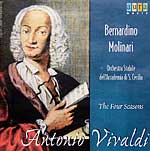 Rather than trying to recreate an early 18th century sound, Bernardino Molinari and the St. Cecilia Academy of Rome sought "natural expression," faithful to the score yet exploiting the full resources of modern instruments, so as to be relevant to a modern audience. A full orchestra of strings and a piano modified to emulate a harpsichord produce a rich texture that really lets us feel the oppressive summer heat, the lust of a peasant dance and storms that owe as much to Beethoven drama than to Baroque decoration. "Romantic" indulgences include portamento (sliding between notes), lush vibrato, strongly shaped phrases, swollen dynamics and huge slowdowns anticipating final cadences. Molinari doesn't hesitate to occasionally modify the score by adding a countermelody, halving or doubling the tempo and repeating the lovely melody of the Winter adagio with full orchestration. Tempos are moderate and the playing is expressive without exaggeration or mannerism. While he may mute the tension, Molinari achieves an ideal balance between the fascination of Vivaldi's vivid writing and the abstract stylization of art. His recording (now on an Aura CD) is of rare distinction and still provides a deeply satisfying and fully musical experience. Rather than trying to recreate an early 18th century sound, Bernardino Molinari and the St. Cecilia Academy of Rome sought "natural expression," faithful to the score yet exploiting the full resources of modern instruments, so as to be relevant to a modern audience. A full orchestra of strings and a piano modified to emulate a harpsichord produce a rich texture that really lets us feel the oppressive summer heat, the lust of a peasant dance and storms that owe as much to Beethoven drama than to Baroque decoration. "Romantic" indulgences include portamento (sliding between notes), lush vibrato, strongly shaped phrases, swollen dynamics and huge slowdowns anticipating final cadences. Molinari doesn't hesitate to occasionally modify the score by adding a countermelody, halving or doubling the tempo and repeating the lovely melody of the Winter adagio with full orchestration. Tempos are moderate and the playing is expressive without exaggeration or mannerism. While he may mute the tension, Molinari achieves an ideal balance between the fascination of Vivaldi's vivid writing and the abstract stylization of art. His recording (now on an Aura CD) is of rare distinction and still provides a deeply satisfying and fully musical experience.
The next recording hailed from Carnegie Hall in late 1947 – very late (after midnight on December 30 and 31, so as to avert a January 1 musicians' strike), by the prolific American violinist Louis Kaufman 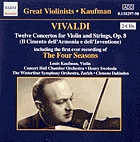 (he played on over 500 movie soundtracks!) and the so-called Concert Hall Chamber Orchestra (a/k/a the strings of the New York Philharmonic) conducted by Henry Swoboda (Naxos). Textures remain somewhat thick (and the harpsichord is buried so deep as to be barely audible), but the timing of 37 1/2 minutes (compared to Molinari's 44:15) was more a harbinger of modern baroque performance practice than the romanticized deliberation of other early recordings. There's no need for the exaggerated claims of the cover blurb ("the first-ever recording of The Four Seasons") or the liner notes (it "single-handedly kindled interest in the music of [Vivaldi]") – beyond its historical significance, Kaufman's keen style is thoroughly enjoyable, the 78s are nicely restored from original materials preserved by his estate, and the budget-priced CD set includes Kaufman's 1950 Swiss recordings of the rest of Il Cimento. (he played on over 500 movie soundtracks!) and the so-called Concert Hall Chamber Orchestra (a/k/a the strings of the New York Philharmonic) conducted by Henry Swoboda (Naxos). Textures remain somewhat thick (and the harpsichord is buried so deep as to be barely audible), but the timing of 37 1/2 minutes (compared to Molinari's 44:15) was more a harbinger of modern baroque performance practice than the romanticized deliberation of other early recordings. There's no need for the exaggerated claims of the cover blurb ("the first-ever recording of The Four Seasons") or the liner notes (it "single-handedly kindled interest in the music of [Vivaldi]") – beyond its historical significance, Kaufman's keen style is thoroughly enjoyable, the 78s are nicely restored from original materials preserved by his estate, and the budget-priced CD set includes Kaufman's 1950 Swiss recordings of the rest of Il Cimento.
The next three decades saw a profusion of Four Seasons recordings –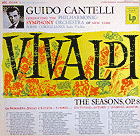 by 1979, a Schwann LP catalog listed nearly as many Seasons (31) as Beethoven Fifths (38). (Indeed, the explosion has continued, with the Seasons now the most popular of all classical works – the Arkivmusic website lists over 120 different recordings currently available!) Yet, only a few fulfilled the conventional A&R appeal of well-known soloists fronting full orchestras led by famous conductors. Of those, perhaps the most stirring is from 1964, with the New York Philharmonic and its concertmaster John Corigliano sparked by the hyperactive continuo of Leonard Bernstein at a amplified harpsichord (Sony 47642), far more vital than the same soloist and orchestra under Guido Cantelli in 1955 (Columbia LP ML 5044, although Cantelli had led the scrappier NBC Symphony in a sharper and more emphatic 1951 concert (As Disc 624)). by 1979, a Schwann LP catalog listed nearly as many Seasons (31) as Beethoven Fifths (38). (Indeed, the explosion has continued, with the Seasons now the most popular of all classical works – the Arkivmusic website lists over 120 different recordings currently available!) Yet, only a few fulfilled the conventional A&R appeal of well-known soloists fronting full orchestras led by famous conductors. Of those, perhaps the most stirring is from 1964, with the New York Philharmonic and its concertmaster John Corigliano sparked by the hyperactive continuo of Leonard Bernstein at a amplified harpsichord (Sony 47642), far more vital than the same soloist and orchestra under Guido Cantelli in 1955 (Columbia LP ML 5044, although Cantelli had led the scrappier NBC Symphony in a sharper and more emphatic 1951 concert (As Disc 624)).
Perhaps the finest "big band" Seasons comes from an unlikely source – Leopold Stokowski. 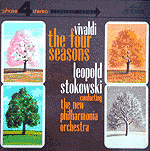 His 1967 Phase 4 recording with the New Philharmonia Orchestra and its leader Hugh Bean (London 433 680) brims with the conductor's characteristic and highly personal tonal color, rescoring and inflection, but it's deeply heartfelt and thoroughly delightful. Indeed, the dynamic continuo and vivid recording even render it highly stylish. At 45 1/2 minutes it's seductively slow, but as Bean once said of Stokowski's generation, they made time vanish. His 1967 Phase 4 recording with the New Philharmonia Orchestra and its leader Hugh Bean (London 433 680) brims with the conductor's characteristic and highly personal tonal color, rescoring and inflection, but it's deeply heartfelt and thoroughly delightful. Indeed, the dynamic continuo and vivid recording even render it highly stylish. At 45 1/2 minutes it's seductively slow, but as Bean once said of Stokowski's generation, they made time vanish.
The trend of superstar lineups 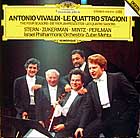 culminated in a 1982 concert recording with the Israel Philharmonic conducted by Zubin Mehta featuring a different soloist in each concerto – Isaac Stern plays "Spring" with sweet gentleness, Pinchas Zukerman treats "Summer" with a steady pulse and dynamic contrasts, Schlomo Mintz presents "Fall" with more pronounced solo presence and tempo variation, and Itzhak Perlman concludes with a "Winter" of surprising objectivity, as if to end with the thought that, when all is said and done, it's all just music (DG 419 214). But the stylistic differences are subtle, and rather than degenerate into a battle of disparate egos, all four blend their personalities into an urbane and satisfying account of secure and confident musicanship that radiates elegance at every turn. culminated in a 1982 concert recording with the Israel Philharmonic conducted by Zubin Mehta featuring a different soloist in each concerto – Isaac Stern plays "Spring" with sweet gentleness, Pinchas Zukerman treats "Summer" with a steady pulse and dynamic contrasts, Schlomo Mintz presents "Fall" with more pronounced solo presence and tempo variation, and Itzhak Perlman concludes with a "Winter" of surprising objectivity, as if to end with the thought that, when all is said and done, it's all just music (DG 419 214). But the stylistic differences are subtle, and rather than degenerate into a battle of disparate egos, all four blend their personalities into an urbane and satisfying account of secure and confident musicanship that radiates elegance at every turn.
In the meantime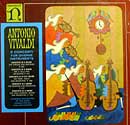 a new phenomenon arose – small and often obscure chamber ensembles, including the Virtuosi di Roma, I Musici, the Solisti di Zagreb, the New York Sinfonietta, the Chamber Orchestra of the Saar and the Academy of St. Martin-in-the-Field, their sudden post-War popularity fueled equally by public thirst for new musical adventure, the enthusiasm of local ensembles for repertoire suitable to their resources and independent record companies' appreciation of lower session costs. Unlike the early bloated orchestral versions that sought to modernize the phrasing, thicken the sound and flesh out harmonies, the small ensembles used only a dozen or so players and respected the original score, written in only five parts – a solo violin, first and second violins, viola, and continuo (the harmonic base, generally comprising a cello plus one or more of a string bass, organ, harpsichord or guitar). That alone was a crucial advance – unlike the universality of Bach, whose music thrives in adaptations, Vivaldi is far more sensitive to timbre, as the charm, impact and very essence of his music only emerge from the way he conceived it. a new phenomenon arose – small and often obscure chamber ensembles, including the Virtuosi di Roma, I Musici, the Solisti di Zagreb, the New York Sinfonietta, the Chamber Orchestra of the Saar and the Academy of St. Martin-in-the-Field, their sudden post-War popularity fueled equally by public thirst for new musical adventure, the enthusiasm of local ensembles for repertoire suitable to their resources and independent record companies' appreciation of lower session costs. Unlike the early bloated orchestral versions that sought to modernize the phrasing, thicken the sound and flesh out harmonies, the small ensembles used only a dozen or so players and respected the original score, written in only five parts – a solo violin, first and second violins, viola, and continuo (the harmonic base, generally comprising a cello plus one or more of a string bass, organ, harpsichord or guitar). That alone was a crucial advance – unlike the universality of Bach, whose music thrives in adaptations, Vivaldi is far more sensitive to timbre, as the charm, impact and very essence of his music only emerge from the way he conceived it.
The next major development came in 1976 with the Concentus Musicus Wein,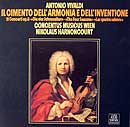 playing on original period instruments with authentic technique based upon performance practices of Vivaldi's time, as researched by its leader, Nikolaus Harnoncourt (whose wife Alice played the solos). The ensemble of 12 played with unprecedented precision, sharp articulation and a wiry, rough-hewn tone, abetted by closely-miked recording that afforded an exceptional feeling of intimacy. Tempos (both fast and slow) and dynamics (mostly very quiet) were startlingly assertive. Yet, although sounding strikingly fresh, the Concentus followed the score scrupulously (Teldec). playing on original period instruments with authentic technique based upon performance practices of Vivaldi's time, as researched by its leader, Nikolaus Harnoncourt (whose wife Alice played the solos). The ensemble of 12 played with unprecedented precision, sharp articulation and a wiry, rough-hewn tone, abetted by closely-miked recording that afforded an exceptional feeling of intimacy. Tempos (both fast and slow) and dynamics (mostly very quiet) were startlingly assertive. Yet, although sounding strikingly fresh, the Concentus followed the score scrupulously (Teldec).
1982 brought two strikingly similar original instrument versions from England –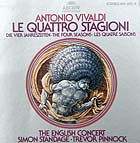 Simon Standage and the English Concert conducted by Trevor Pinnock (Archiv) and the Academy of Ancient Music led by Christopher Hogwood (l'Oiseau-Lyre), who rotated his soloists, following Vivaldi's own practice. The Consort has somewhat more bracing tempos while the Academy is slightly freer and more subtle, but both present a smoother, more blended view than Harnoncourt, with moderate pacing, tastefully ornamented solos, and a deeper sonority to extend the appeal of historically-informed performance with playing that's assured, incisive and satisfying. Simon Standage and the English Concert conducted by Trevor Pinnock (Archiv) and the Academy of Ancient Music led by Christopher Hogwood (l'Oiseau-Lyre), who rotated his soloists, following Vivaldi's own practice. The Consort has somewhat more bracing tempos while the Academy is slightly freer and more subtle, but both present a smoother, more blended view than Harnoncourt, with moderate pacing, tastefully ornamented solos, and a deeper sonority to extend the appeal of historically-informed performance with playing that's assured, incisive and satisfying.
The final step toward the current fruition of Vivaldi interpretation was to apply personal impulse to augment the written text, while remaining secure in the period style. 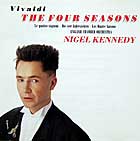 Whether a contributor to or reflection of the surging interest in Vivaldi, the 1989 CD by Nigel Kennedy and the English Chamber Orchestra (EMI) reportedly is the best-selling classical recording of all time. All too often, massive sales are gained through inoffensive blandness or cross-over compromises, but not here. Indeed, critics pounced on its aggressive waywardness. Despite using modern instruments and opting for an overall smooth sound, the precision, embellishments and tempo variation of the playing are highly idiomatic. But by Autumn, things get bizarre. Kennedy precedes the adagio with a whiny siren-like dirge, plays the ensuing solo in screechy harmonics, precedes the allegro with more wheezing and adds percussive sounds emulating gunshots to the final hunt. In Winter, he illustrates the "horrid wind" with more harmonics and precedes its largo with an unabashedly virtuostic cadenza. Whether a contributor to or reflection of the surging interest in Vivaldi, the 1989 CD by Nigel Kennedy and the English Chamber Orchestra (EMI) reportedly is the best-selling classical recording of all time. All too often, massive sales are gained through inoffensive blandness or cross-over compromises, but not here. Indeed, critics pounced on its aggressive waywardness. Despite using modern instruments and opting for an overall smooth sound, the precision, embellishments and tempo variation of the playing are highly idiomatic. But by Autumn, things get bizarre. Kennedy precedes the adagio with a whiny siren-like dirge, plays the ensuing solo in screechy harmonics, precedes the allegro with more wheezing and adds percussive sounds emulating gunshots to the final hunt. In Winter, he illustrates the "horrid wind" with more harmonics and precedes its largo with an unabashedly virtuostic cadenza.
Is such stuff authentic or a perversion? Despite all the recent scholarship, it's hard to say. Vivaldi himself was reputed to be a daring, "freakish" technician; one of the few accounts of his playing predicted Paganini, by describing his fingers so close to the bridge that there was barely room for the bow. Scholars who have studied Vivaldi's autograph scores note that the published versions are often simplified to encourage accessibility, thus suggesting that actual performances were more daring. They further assume that what appears to be tedious repetitive sequencing was enlivened with extemporized variety. Yet, these works were meant for girls in a convent to display their poise before well-heeled patrons, and what may have passed for wild abandon in its time could be quite mild by modern standards. Even if not a first choice, Kennedy seems solidly within the Vivaldi spirit.
Yet, unbridled personality can go too far. 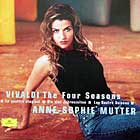 A 1999 disc by Anne-Sophie Mutter and the Norwegian Trondheim Soloists (DG) is a throwback not to Vivaldi but only halfway, to the ego-driven interpretive extremes of the 19th century. Perhaps to assert her independence from the stifling shadows of her mentor von Karajan, with whom she made a highly polished Vienna Philharmonic recording in 1984, there's not even a pretense of credible style; rather, Mutter constantly screams for attention in every way, from the vixen cover photo, fatuous "interview" and cheesecake portraits of the CD booklet to her fat tone, lush vibrato, wild tempos and overriding obsession with virtuosity. It's undeniably involving and often exciting, but Vivaldi gets left in the dust as Mutter's super-charged sports car zooms away. A 1999 disc by Anne-Sophie Mutter and the Norwegian Trondheim Soloists (DG) is a throwback not to Vivaldi but only halfway, to the ego-driven interpretive extremes of the 19th century. Perhaps to assert her independence from the stifling shadows of her mentor von Karajan, with whom she made a highly polished Vienna Philharmonic recording in 1984, there's not even a pretense of credible style; rather, Mutter constantly screams for attention in every way, from the vixen cover photo, fatuous "interview" and cheesecake portraits of the CD booklet to her fat tone, lush vibrato, wild tempos and overriding obsession with virtuosity. It's undeniably involving and often exciting, but Vivaldi gets left in the dust as Mutter's super-charged sports car zooms away.
Among other highly acclaimed readings, Jeanne Lamon and the Canadian Tafelmusik (Sony VivArte) are cleanly articulated, balanced, graceful and tastefully embellished. At the opposite end of the spectrum is the emotional gamut of Giuliano Carmignola and the Venice Baroque Orchestra led by Andrea Marcon (Sony), who meld bold impetuosity and sweet lyricism into a compelling brew that bristles with energy (their summer storm is truly staggering) and creativity (adding a Kennedy-esque cadenza before the Winter adagio, which they accompany with a pop-tinged plucked bass to mark each downbeat); as a bonus they toss in world premiere recordings of three recently discovered Vivaldi concerti. Jeanne Lamon and the Canadian Tafelmusik (Sony VivArte) are cleanly articulated, balanced, graceful and tastefully embellished. At the opposite end of the spectrum is the emotional gamut of Giuliano Carmignola and the Venice Baroque Orchestra led by Andrea Marcon (Sony), who meld bold impetuosity and sweet lyricism into a compelling brew that bristles with energy (their summer storm is truly staggering) and creativity (adding a Kennedy-esque cadenza before the Winter adagio, which they accompany with a pop-tinged plucked bass to mark each downbeat); as a bonus they toss in world premiere recordings of three recently discovered Vivaldi concerti.
If you'd just as soon get 12 concertos for the price of 4, there are some fine choices among budget sets of the complete Il Cimento. Talbot notes that it's curious that Vivaldi, who often capitalized on his past successes, never followed up the Seasons with another themed group of concertos, but several others in the Il Cimento collection are broadly descriptive: # 5 depicts "The Storm at Sea," # 6 leaps with "Pleasure," and # 10 is a rollicking "Hunt." Monica Huggett and the Raglan Baroque Players led by Nicholas Kraemer (1990, Virgin) are exquisitely sensitive to nuances of timbre and dynamics without lapsing into sentimentality and include two bonus concerti. (Don't get excited by the seemingly breathless timings listed on the label, though – they're all fictitious!) there are some fine choices among budget sets of the complete Il Cimento. Talbot notes that it's curious that Vivaldi, who often capitalized on his past successes, never followed up the Seasons with another themed group of concertos, but several others in the Il Cimento collection are broadly descriptive: # 5 depicts "The Storm at Sea," # 6 leaps with "Pleasure," and # 10 is a rollicking "Hunt." Monica Huggett and the Raglan Baroque Players led by Nicholas Kraemer (1990, Virgin) are exquisitely sensitive to nuances of timbre and dynamics without lapsing into sentimentality and include two bonus concerti. (Don't get excited by the seemingly breathless timings listed on the label, though – they're all fictitious!)
Fabio Biondi and Europa Galante (2000, Virgin)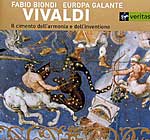 are passionately inventive, applying a startling arsenal of techniques from a vertiginous skipping bow to a strikingly modern slap-bass, but claim as the source of their fantasy not personal whim but contemporaneous manuscripts that exhibit considerably more freedom than the published score. For their Four Seasons, they use a set of instrumental parts made in Rome in 1740, in which the different harmonies, textures, transpositions and articulation possibly reflect Vivaldi's actual performance practices more accurately than the simplified published version we have come to regard as definitive. are passionately inventive, applying a startling arsenal of techniques from a vertiginous skipping bow to a strikingly modern slap-bass, but claim as the source of their fantasy not personal whim but contemporaneous manuscripts that exhibit considerably more freedom than the published score. For their Four Seasons, they use a set of instrumental parts made in Rome in 1740, in which the different harmonies, textures, transpositions and articulation possibly reflect Vivaldi's actual performance practices more accurately than the simplified published version we have come to regard as definitive.
This article was based primarily upon research and factual material contained in the following sources:
Marc Pincherle – Vivaldi: Genius of the Baroque (Norton, 1957) – a translation of the very first (1948) biography of the previously-neglected composer. Pioneering into then-unexplored territory, Pincherle provides a fine analysis of the structural features of Vivaldi's output. Incidentally, Pincherle's was also the first to compile a systematic catalog of Vivaldi's work – he's the "P" in the numbering you may see (as in the "Spring" concerto of the Four Seasons being listed as P. 241). Three more catalogs would follow by Rinaldi, Fanna and Ryom, none of their numbering schemes having any logical connection with the others.
Michael Talbot – Vivaldi (Schirmer, 1992) – another seminal work with a fine summary of Vivaldi's style. Talbot also contributed the article on Vivaldi in volume 26 of the New Grove's Dictionary of Music and Musicians (McMillan, 2001). Although still titled a "dictionary," Grove's has evolved from its initial publication in 1876 into a highly authoritative and vastly detailed encyclopedia.
H.C. Robbins Landon – Vivaldi – Voice of the Baroque (Thames & Hudson, 1993).
Nikolas Harnoncourt – notes to the 1977 Telefunken/Das Alte Werk LP of the Seasons by his Concentus Musicus Wein that pioneered the original instrument trend, in which he provides a thoughtful discussion of performance practice from the perspectives of historical convention and artistic context.
Joseph Braunstein – notes to Vivaldi's 5 Concerti for Diverse Instruments by the Chamber Orchestra of the Saar (Nonesuch LP H-71104), in which he details the 1926 discovery and handling of the Vivaldi cache.
Piero Rattalino – notes to the 1999 CD transfer of the 1942 Molinari recording (Aura CD 192-2), in which he recalls the fascinating political (!) and cultural history of the very first Seasons recording.

Copyright 2004 by Peter Gutmann
|
